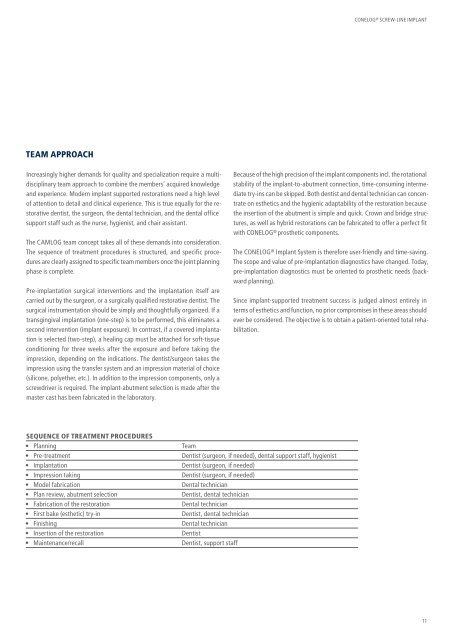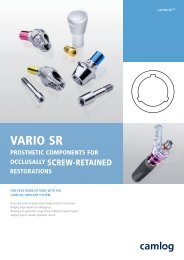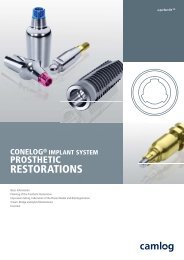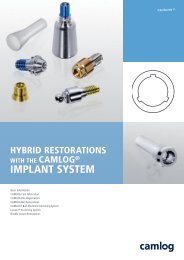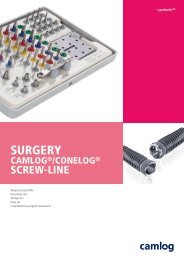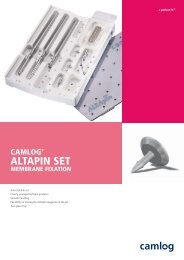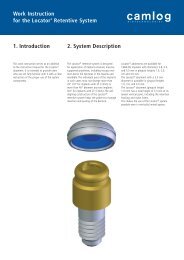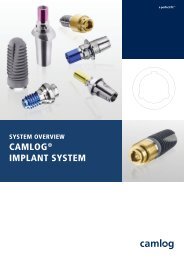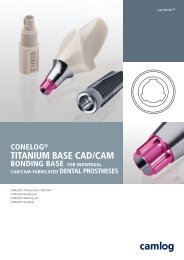CONELOG® SURGICAL PROCEDURES - Camlog
CONELOG® SURGICAL PROCEDURES - Camlog
CONELOG® SURGICAL PROCEDURES - Camlog
You also want an ePaper? Increase the reach of your titles
YUMPU automatically turns print PDFs into web optimized ePapers that Google loves.
TEAM APPROACH<br />
Increasingly higher demands for quality and specialization require a multidisciplinary<br />
team approach to combine the members’ acquired knowledge<br />
and experience. Modern implant supported restorations need a high level<br />
of attention to detail and clinical experience. This is true equally for the restorative<br />
dentist, the surgeon, the dental technician, and the dental office<br />
support staff such as the nurse, hygienist, and chair assistant.<br />
The CAMLOG team concept takes all of these demands into consideration.<br />
The sequence of treatment procedures is structured, and specific procedures<br />
are clearly assigned to specific team members once the joint planning<br />
phase is complete.<br />
Pre-implantation surgical interventions and the implantation itself are<br />
carried out by the surgeon, or a surgically qualified restorative dentist. The<br />
surgical instrumentation should be simply and thoughtfully organized. If a<br />
transgingival implantation (one-step) is to be performed, this eliminates a<br />
second intervention (implant exposure). In contrast, if a covered implantation<br />
is selected (two-step), a healing cap must be attached for soft-tissue<br />
conditioning for three weeks after the exposure and before taking the<br />
impression, depending on the indications. The dentist/surgeon takes the<br />
impression using the transfer system and an impression material of choice<br />
(silicone, polyether, etc.). In addition to the impression components, only a<br />
screwdriver is required. The implant-abutment selection is made after the<br />
master cast has been fabricated in the laboratory.<br />
CONELOG ® SCREW-LINE IMPLANT<br />
Because of the high precision of the implant components incl. the rotational<br />
stability of the implant-to-abutment connection, time-consuming intermediate<br />
try-ins can be skipped. Both dentist and dental technician can concentrate<br />
on esthetics and the hygienic adaptability of the restoration because<br />
the insertion of the abutment is simple and quick. Crown and bridge structures,<br />
as well as hybrid restorations can be fabricated to offer a perfect fit<br />
with CONELOG ® prosthetic components.<br />
The CONELOG ® Implant System is therefore user-friendly and time-saving.<br />
The scope and value of pre-implantation diagnostics have changed. Today,<br />
pre-implantation diagnostics must be oriented to prosthetic needs (backward<br />
planning).<br />
Since implant-supported treatment success is judged almost entirely in<br />
terms of esthetics and function, no prior compromises in these areas should<br />
ever be considered. The objective is to obtain a patient-oriented total rehabilitation.<br />
SEQUENCE OF TREATMENT <strong>PROCEDURES</strong><br />
• Planning Team<br />
• Pre-treatment Dentist (surgeon, if needed), dental support staff, hygienist<br />
• Implantation Dentist (surgeon, if needed)<br />
• Impression taking Dentist (surgeon, if needed)<br />
• Model fabrication Dental technician<br />
• Plan review, abutment selection Dentist, dental technician<br />
• fabrication of the restoration Dental technician<br />
• first bake (esthetic) try-in Dentist, dental technician<br />
• finishing Dental technician<br />
• Insertion of the restoration Dentist<br />
• Maintenance/recall Dentist, support staff<br />
11


